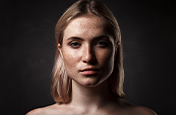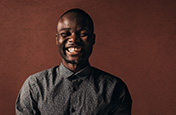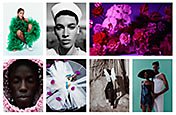Types of fashion photography
Fashion photography is about pushing creative boundaries to inspire people with beauty, style and elegance. “For me, it's a form of art that requires an avid eye for detail, creativity and understanding of the latest fashion trends,” explains professional fashion photographer Karen Woo.
There are many types of fashion photography:
- Editorial fashion photography: storytelling for fashion print and online magazines;
- Commercial fashion photography: promoting fashion products;
- High fashion photography: featuring high-end models, locations and luxury designer clothing; and
- Street fashion photography: capturing everyday style worn by people on the streets.
Regardless of the type of fashion photography, choosing the best lens and camera settings is essential to showcasing fashion in the best light.

Editorial fashion photography 2020.
photography KAREN WOO
art direction LEROY LORENZO
hair SAM BATTENALLY
makeup KATE RADFORD
fashion TORANNCEtalent MARLENE KAFKA represented by CHADWICKS MODELS

Editorial fashion 2020 photography.
photography KAREN WOO
art direction EMILY EDWARDS
hair & makeup KATE RADFORD
fashion TONI MATICEVSKI
talent SHIYING HE represented by VIVIENS MODELLING AGENCY

Street style fashion photography.
Talent BAMBI CHEUNG
Type of lenses used by fashion photographers
Prime lenses of 35 mm, 50 mm and 85 mm are the best fashion lenses typically used by fashion photographers to achieve the desired effect, mood and story.
“35 mm prime lens with f/1.8 aperture is my go-to for editorial and commercial photography,” Woo says. “It’s wide enough to capture fashion in full-length and creative angles, it’s light-weight and it is optimal for the light it lets in and the shallow depth of field it provides.”
Fashion photographers create the bokeh effect to draw attention to a subject by separating the subject and the background. It makes a dreamy, ethereal quality in a photograph or it can add visual interest to an otherwise distracting or unremarkable background. Prime lens is popular for this, because it is fast and has the widest aperture, such as f/2.8, f/2, f/1.8 or f/1.4.
However, fashion photographers may prefer using zoom lenses of 24-70 mm and 70-200 mm to capture a range of shots without constantly switching lenses. Zoom lenses can be efficient for fast-paced e-commerce fashion shoots, particularly in situations where there isn't enough time to switch lenses or when space is limited.
The zoom lens allows for adjusting the focal length to get interesting wide-angle shots, mid-range shots or close-up shots without changing lenses, enabling more flexibility to capture the subject quickly and efficiently.
Over the past 10 years, Karen has travelled to Sydney, London, Paris and New York to capture street style fashion and from experience, she highly recommends investing in a 70-200 mm lens.
“It’s the best lens for street fashion photography because you can be a ‘fly-on-the-wall’ and take photos of fashion models and influencers’ style at fashion week events without interrupting them.”
Additionally, the zoom lens compresses the perspective beautifully, so the subject and background are more connected to each other. The depth of field creates a soft out-of-focus background which is often desirable in street fashion photography.

From left to right, Nikon Z 6 with Nikkor Z 70-200 mm, Z 85 mm, Nikkor Z 50 mm & Nikkor Z 35 mm lens.
The best lenses for fashion show backstage and runway photography
Choosing the best lens for photographing the fashion runway and backstage depends on a variety of factors, including the image aesthetic, specific fashion client brief, lighting situation, location space or the photographer’s personal preferences.
“As a photographer working backstage at a runway show, it’s usually bustling, dark and intense, but exciting at the same time. There are models, make-up and hair stylists, photographers and dressers getting ready and vying for space. This means I have to work quickly within a limited space and time.”

Backstage fashion photography at Melbourne Fashion Week 2018 using Nikon 810 and Nikon AF-S 24-70 mm lens.
To cover all the necessary shots, Karen vouches for either the 35 mm f1.8 prime lens or the 24-70 mm zoom lens.
“These lenses are the most reliable in dark and limited spaces. I can simply focus on capturing the models’ personalities either in a group or individually, their hair and make-up, outfit details and context, without having to worry if the photos would turn out blurry or noisy.”
As for fashion runway photography, a fast camera, a sharp lens, a good position, a keen eye and a quick trigger finger is the essence of the perfect runway photo.
“Once you're in the photographer's media pit, it's game on!” says Karen. Camera settings are manually adjusted on the fly to accommodate the dramatic lighting and anticipate the models' movement. And of course, the right lens to capture stunning shots is key.
The ideal long focal lens is the 70-200 mm f/2.8 for full-length and close-up shots if you are sitting in the media pit which is a designated location for photographers to take their fashion runway images. From this position, they get a front-on view of the models walking down the runway.
“From my perspective, I always seek out unique viewpoints, so I prefer to work from an allocated seated location, typically in the front row. When shooting from this position, the 24-70 mm lens is my favourite because it allows me to effortlessly capture both wide and close-up shots without having to constantly switch lenses.”

Paypal Melbourne Fashion Festival 2021 using Nikon Z 6 and Nikkor Z 50 mm lens.

Thom Browne Show 2018 using Nikon Z 7 and Nikkor AF-S 70-200 mm lens.
Wide angle fashion photography
Wide angle lenses have recently become popular and powerful for fashion photographers looking to create dynamic, immersive images that capture the essence of their subject and environment.
"My favourite wide-angle lens is the Nikon 14-30 mm f/4.0 because it exaggerates my angles and creates a dynamic-looking image with a strong sense of movement. It usually draws the viewer into the image and conveys a sense of energy."
Wide angle lens’ in fashion photography allow photographers to create a sense of depth and space in their images. By including more of the environment in the frame, wide-angle lenses can create a greater sense of context and atmosphere, providing viewers with a more immersive experience.
However, it's worth noting that using a wide-angle lens can also present some challenges. Because of their wide-angle view, wide-angle lenses can introduce distortion and stretching of the subject, which can be unflattering in fashion photography. Additionally, wide-angle lenses may also require photographers to get in closer to their subjects, which can be challenging in crowded or tight spaces.

Plant Parent editorial photography 2022 using Nikon Z 6 and Nikkor Z 14-30 mm lens
photography & direction KAREN WOO
talent WILLIAM CRABB
art direction & style LEROY LORENZO
hair NIKKI PORTER
makeup KATE RADFORD
publication L’EFRONTE MAGAZINE
Best lens for street style photography
When it comes to street fashion photography, there are a few types of lenses that are particularly well-suited to the genre. A few popular options are
- 50 mm prime lens: fast, lightweight and versatile, making it ideal for capturing candid shots of people on the street
- 85 prime lens: fast, lightweight and versatile
- 70-200 zoom lens: versatile and compresses the subject and background closer together but is a heavier lens choice.
- Another popular option is a wide-angle lens, such as the 14-30 mm, 35 mm prime lens or a 24-70 mm zoom lens, which allows photographers to capture more of the environment and create a sense of context in their images.
Ultimately, the best lens for street fashion photography will depend on the photographer's personal preferences and shooting style, as well as the specific requirements of the shoot.

Paypal Melbourne Fashion Festival 2022, Dan Brown and Maxine Wylde using Nikon Z 6 and Nikkor Z 70-200 mm lens.
Elevating fashion images in Lightroom
Once the shoot is finished, Karen spends time culling and rating the images in Adobe Bridge and then imports a top selection of images into Adobe Photoshop Lightroom for colour grading.
"Colour grading is an important aspect in image post-production because this is where you get to have fun and apply your own artistic flair that can set you apart from other photographers." explains Karen. This process also results in more consistent, polished and professional-looking images that are print and digital ready. Here are her top tips to enhancing fashion images in Lightroom:
- Use the Adjustment Brush to selectively brighten or darken parts of the image so you enhance specific details of the garment or model's features.
- Use the Healing Brush to selectively remove distractions in the background, marks on the garments or simple skin retouching.
- Use the Hue and Luminance slider to selectively brighten or darken a specific colour of the image, such as enhancing the detail of the model's skin tones, garment or even the sky.
- Experiment with Midtones, Shadows and Highlights to elevate the overall look and feel of the overall image.

Paypal Melbourne Fashion Festival 2021, Bec and Marissa of Twice Blessed.
Before (Left) and After (Right) image using Adobe Lightroom for colour grading and healing.
Karen encourages beginner fashion photographers to spend the time to experiment with different Lightroom settings until the desired effect is achieved. Then create your own Preset so you can apply the Preset again on your next photo series.
Lastly, try to carry a camera with you because you never know what fascinating subjects or elements you may come across. Train your eye to seek out window displays, the way people wear clothes, the textures, colours, lighting or even conversations.
"The inspiration and everyday moments you gather can transform into your next big idea." Karen excitingly reveals.
With a creative eye and a willingness to explore the world around you, you can elevate your photography skills and produce truly stunning fashion images.
To find out more about how you can use Adobe Photoshop Lightroom to take your fashion photography to the next level, visit our Fashion Photography page.
Contributors:
Creating great portrait photography.
Take a step closer to perfect portraits with tips and advice from professional photographers.
An introduction to portrait lighting.
Learn the basics of portrait lighting to bring your subject’s story to life.
Tips for upskilling creative fashion photography skills
Learn how to plan and execute the perfect creative fashion photograph that showcases your vision and style.
An introduction to editorial fashion photography
Learn the basics of editorial fashion photography and explore its creative potential with tips from professional photographer.



